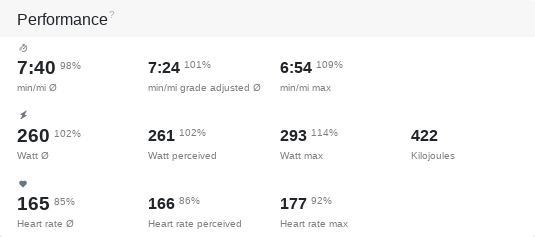Performance
Performance
Performance values are the attributes of an activity that directly influence the effort required for a training.

Speed - pace or tempo?
Pace and tempo are each speed quantities, but differ in scale and reference order.
In the context of Tredict, running, swimming or other activities are referred to as pace. The time refers to the distance: min/km, min/mi, min/100m, min/100yd.
Cycling is generally referred to as tempo, as high speeds are reached and pace is no longer a good benchmark. The distance refers to the time: km/h, mi/h.
Tredict determines the speed from 2 possible data fields of your recording device.
Pace/Tempo by Distance
The continuous distance in relation to the duration gives the speed.
Tredict uses the pace by distance per default, as this is most accurate with normal GPS sports watches.
Pace/Tempo by Speed
The data field "Speed in meters per second" is additionally provided by many sports watches.
This field is somewhat less accurate for normal GPS sports watches, as the value is directly dependent on satellite reception. Therefore, there is often a discrepancy between the pace from distance and pace from speed.
But when using a footpod when running or a speedometer when cycling, the pace from speed can provide the much more precise values.
If you are using an extra footpod and the pace from distance and pace from speed show a high discrepancy, your footpod may not be calibrated correctly or may have an incorrectly set correction factor.
Speed and distance measurement may diverge
The pace from distance and the pace from speed can differ significantly if GPS reception is poor or the speedometer is incorrectly calibrated.

You can switch between the two modes with a click on the Pace/Tempo field.
You can set this permanently in the training settings.
Grade adjusted pace
For the altitude correction of the speed, first the gradients from the altitude data series are determined and slightly smoothed. Using the gradients, an energy cost calculation (according to Minetti and others) is carried out and the speed is corrected.
Grade adjusted speed is the basis of the "Effort calculation according to speed".
Speed, like wattage, is an output quantity, because something already achieved is measured.
Power / Watt
Wattage is another output variable that shows you how much power you actually put on the "road".
It is independent of ascents, descents or wind (for power meters with wind sensor) and thus provides more accurate values in the effort calculation compared to speed.
On an ideal course (flat and calm), pace and wattage are practically proportional to each other during a normal workout. Only at very high speeds is there a clear digression between power output and speed gain.
Specific Power - Watt/kg
Specific power shows wattage in relation to your body weight and thus establishes comparability to other athletes.
By clicking on the performance values you can switch to the specific power.
However, comparability is only given if all athletes use identical or compatible power meters.
Perceived Power
With the perceived wattage, the lower values are raised according to a specific ratio and the higher values are lowered.
The power is thus normalized.
Normalizing power is a trick and better reflects the perceived work done.
- A strenuous interval training has a higher value than the average wattage.
- A long, very even run has no difference in perceived and average power.
The Perceived Power is the basis of the "effort calculation by power".
Heart rate
The average heart rate is an important indicator of training control. It shows the actual intensity of your workout and responds to your daily form or illnesses.
In combination with speed or wattage, you can make reliable statements about your current aerobic performance (see Heart Rate Pace Factor, Heart Rate Power Factor).
Heart rate is the most important input variable and has direct effects on output variables such as pace and power.
The average heart rate is the basis of the "effort calculation by heart rate".
Perceived Heart Rate
The Perceived Heart Rate, like the Perceived Power, is a normalized value and reflects the true effort of the training in more detail.
Percentages of capacity
The percentages behind the performance values tell you what percentage of the maximum capacity was achieved during training.
Since FTP is a value with time reference to 60 minutes, valid percentage values of over 100% are possible.
- Pace % -> Percent of the Functional Threshold Pace (FTPa).
- Watt % -> Percent of Functional Threshold Power (FTP).
- Heart rate % -> Percent of maximum possible Heart Rate.
Respiration rate
The respiratory rate usually increases directly with the increase in exercise intensity, at higher altitudes or when a state of exhaustion arises due to prolonged exercise.
The combination of maximum respiration rate, lung volume and number of pulmonary alveoli results in the oxygen uptake capacity.
Oxygen saturation
Oxygen saturation under heavy strain shows you when your body can no longer maintain the optimal oxygen supply to your muscles. This value is therefore an important control instrument in altitude training to protect against oxygen deficiency.
Total hemoglobin
The total hemoglobin value indicates the number of oxygen-carrying red blood cells. Values around 12-17 grams per deciliter are within a reasonable range. The haemoglobin value can rise due to altitude training or thickening of the blood (loss of fluid) or drop due to mechanical damage during very long exertion on the soles of the feet.
A fitness watch, chest strap and/or footpod is required to provide and support these metrics.